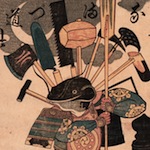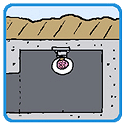|
Veins McGee posted:Was it that Western observers thought that the Soviets were incapable of creating a technically sound tank or incapable of developing a sound doctrine for employment? Vladimir Mostovenko posted:There is little to be gained in disputing this statement, since the results of our tank building industry…present a very convincing reply to such fantasy; bear in mind the following points: In other words, the Soviets realized they were at a disadvantage, and took every opportunity to catch up in the latest arms race. What Westerners failed to realize was that the Russians could in fact not only catch up, but even pull ahead in that race. As for doctrine, some think that the Russians got everything from the Germans through the cooperative school at Kazan. However, if you check out Mary R. Habeck's Storm of Steel, she makes it clear that Soviet doctrine evolved largely independently. Veins McGee posted:In 1988 there were only the Arab/Israeli wars to use as a basis for making claims and the conclusions that can be drawn from these engagements are extremely limited(Export versions/obsolete tanks, training of crews, doctrine)
|
|
|
|

|
| # ? Apr 26, 2024 11:30 |
|
Admiral Snackbar posted:One of the things that doesn't get much attention is the fact that the Russian tanks being used by the Arab countries didn't have any kind of air conditioning. Just imagine being stuck in a large oven in the midst of battle and trying to fight effectively. I wouldn't necessarily say this was a design flaw, since, as you say, they were export versions and should have been appropriately equipped by the end users.  Veins McGee posted:http://en.wikipedia.org/wiki/Sino%E2%80%93Soviet_border_conflict Interesting, I didn't know that this came to blows after Lake Khasan. Most interesting is this, though quote:Further border clashes occurred in August 1969, this time along the western section of the Sino–Soviet border in Xinjiang. Heightened tensions raised the prospect of a nuclear war between China and the Soviet Union. In the early 1960s, the United States had "probed" the level of Soviet interest in joint action against Chinese nuclear weapons facilities; now the Soviets probed what the United States' reaction would be if the USSR attacked the facilities.[4] I'm pretty amazed that the Russians and the Chinese nearly came to nuclear blows; I absolutely never learned about this in school. Volmarias fucked around with this message at 04:10 on Aug 23, 2011 |
|
|
|
Admiral Snackbar posted:One of the things that doesn't get much attention is the fact that the Russian tanks being used by the Arab countries didn't have any kind of air conditioning. Just imagine being stuck in a large oven in the midst of battle and trying to fight effectively. I wouldn't necessarily say this was a design flaw, since, as you say, they were export versions and should have been appropriately equipped by the end users. drat, I knew export tanks were stripped down, but I didn't know they were that stripped down.
|
|
|
|
In WWII what did the Western allies do with all of the tanks and guns they must have captured during the war? Did they use them for anything during the conflict? I assume they were destroyed after the war.
|
|
|
|
OctaviusBeaver posted:In WWII what did the Western allies do with all of the tanks and guns they must have captured during the war? Did they use them for anything during the conflict? I assume they were destroyed after the war. It was hard enough for the Germans to maintain their own vehicles, while there was initially a bit of enthusiasm for using captured German equipment because it was so much better (iirc at one point in the counter attacks during the Battle of the Bulge a whole machine shop full of Panthers was captured intact), it quickly waned once everyone realised that there were no spare parts for them.
|
|
|
|
The French used Panthers for a while after the war, and a bunch of German equipment was sold off to the Middle East, off the top of my head. The Syrians used PzIV's. Of course, Finland too kept PzIV's in use after the war.
|
|
|
|
I'm pretty sure the remains of the submarine fleet were divided among the allies too, norway and England got some each I believe
|
|
|
|
Alchenar posted:It was hard enough for the Germans to maintain their own vehicles, while there was initially a bit of enthusiasm for using captured German equipment because it was so much better (iirc at one point in the counter attacks during the Battle of the Bulge a whole machine shop full of Panthers was captured intact), it quickly waned once everyone realised that there were no spare parts for them. Did this not cause any friendly fire? I remember reading that Typhoons (or maybe Tempests?) had to have extra markings painted on them because so many other Allied fighters mistook them for Fw190s. I can't imagine the trouble actually using enemy equipment would make, except in the most unusual situations.
|
|
|
|
Kemper Boyd posted:The French used Panthers for a while after the war, and a bunch of German equipment was sold off to the Middle East, off the top of my head. The Syrians used PzIV's. Of course, Finland too kept PzIV's in use after the war. Israel, too! The Israeli army used German helmets and Kar98ks for a period of time, until they got their own industry going.
|
|
|
|
Ensign Expendable posted:Israel, too! The Israeli army used German helmets and Kar98ks for a period of time, until they got their own industry going.
|
|
|
|
Ensign Expendable posted:drat, I knew export tanks were stripped down, but I didn't know they were that stripped down. I don't know if it's really a question of stripped down versions. An actual air conditioning that works in all climates has been a comparatively late option in fighting vehicles in general, mostly because all the big manufacturers have been in temperate climates where a bigger problem is sufficient heating in the winter. Also a more important issue is protection from NBC weaponry, which is achieved by generating a slight overpressure in the crew compartment when all hatches are closed. For example, Australia used to have West German-built Leopard 1's and they too lacked air conditioning which you'd sorely need in Australian summer. The same issue with Leopard 1 caused Canadian forces to upgrade to the modern Leopard 2 while deployed in Afghanistan. These weren't stripped out budget models, you just don't need air conditioning in Berlin where the average temperature is 9ºC. And in 1970's air conditioning was a luxury item deemed inappropriate for military vehicles.
|
|
|
|
Um, yeah...not even the Abrams is air conditioned. The A2 sort of is, it has some cooling for the electronics, but it doesn't do much for the crew (I think it is specified to keep the cabin below either 125 or 100 degrees). In fact the Leopard 2 is the only tank I can think of that has anything close to an actual functional air conditioner for the crew.
|
|
|
|
Why are tank guns smoothbore instead of rifled?
|
|
|
|
Ograbme posted:Why are tank guns smoothbore instead of rifled? http://en.wikipedia.org/wiki/Tank_gun#Smoothbore Short answer: the Soviets so that their tanks could fire ATGMs, NATO because it turns out that fin-stabilised shells are more accurate than shells fired from a rifle so long as your smoothbore barrel is manufactured to the right standards.
|
|
|
|
Alchenar posted:Short answer: the Soviets so that their tanks could fire ATGMs, NATO because it turns out that fin-stabilised shells are more accurate than shells fired from a rifle so long as your smoothbore barrel is manufactured to the right standards. And the Challenger 2 still uses a rifled gun.
|
|
|
|
feedmegin posted:And the Challenger 2 still uses a rifled gun. We're planning an upgrade program now. The MoD will either have to find the cash for it somewhere or at some point in the future we'll run out of shells.
|
|
|
|
Ograbme posted:Why are tank guns smoothbore instead of rifled? The above answers are correct, i'll just add one more. HEAT rounds are less effective when spun, because the centrifugal spin weakens the liner.
|
|
|
|
Re. smoothbore vs. rifled tank guns, this is anecdotal from a tanker buddy of mine. Rifled guns are more accurate at most ranges, decisively so at very long ranges. A spinning round is less affected by wind, thermals, etc, than is a purely fin stabilized round, and over long distances this almost always adds up. This, plus their hardon for HESH shells, is why the Brits chose to keep a rifled barrel. It does work as intended, at ranges past 2km the British gun is a lot more accurate than the 256 (and British tankers like pointing this out apparently, particularly in combined gunnery exercises). The smoothbore barrel wears down a lot more slowly with all rounds; it allows a higher muzzle velocity for a given charge, and works better with HEAT rounds. The main reasons that everyone else switched to smoothbore are: 1) computers started to do a much better job of compensating for wind and thermal effects, and 2) tanks very, very rarely will see an engagement at the distances where a rifled barrel will provide an advantage; and at normal combat ranges (inside 1500m) the 256 will hit harder for a given charge while maintaining adequate accuracy. Plus, the smoothbore barrel's higher velocity allows for a flatter trajectory, which simplifies the computer's calculations a bit which is nice at close ranges. bewbies fucked around with this message at 20:02 on Aug 25, 2011 |
|
|
|
I have a few Napoleon questions... Being bogged down in Spain, in poor health and well aware of the logistics involved, why did he go into Russia? If he had not of gone into Russia, would they have invaded Poland knowing they would be fighting the armies of Europe on their turf?
|
|
|
|
ganglysumbia posted:Being bogged down in Spain, in poor health and well aware of the logistics involved, why did he go into Russia? His plan for Russia was actually not unreasonable given the way his previous campaigns had worked out. First he would confront the Russian army and inflict a decisive defeat, then he would take Moscow and the Tsar would capitulate. Even if Alexander I didn't give in immediately, Napoleon could make winter quarters in Moscow, and when the next campaign season came around he would be ready to tear the country apart, at which point the Tsar would have to offer terms anyway. The plan simply went wrong, because the Russians were able to withdraw their army from Borodino relatively intact, and when Napoleon entered Moscow it had been stripped and then it burned to the ground, leaving him pretty much screwed. quote:If he had not of gone into Russia, would they have invaded Poland knowing they would be fighting the armies of Europe on their turf? They apparently had plans to do so, because they felt the Napoleon-aligned Duchy of Warsaw was a threat to their security. Napoleon was the aggressor, but Alexander had taken provocative actions like withdrawing from the continental system, so conflict was likely inevitable. If Napoleon hadn't struck first, the Russians probably would have in order to be in a better position to resist when he inevitably did come for them.
|
|
|
|
Napoleons plans were first and foremost to make the Tsar yield, not completely eliminate him or Russia as he wanted him as a possible future ally against europe. A good example of this is when several russian student cliques and intellectuals offered to help Napoleon by starting a big scale underground propaganda war, something that could have kickstarted the russian revolution before Lenin was even born, however he turned them down as his plan needed the Russian monarchy to be somewhat intact.
|
|
|
|
EvanSchenck posted:His plan for Russia was actually not unreasonable given the way his previous campaigns had worked out. First he would confront the Russian army and inflict a decisive defeat, then he would take Moscow and the Tsar would capitulate. Even if Alexander I didn't give in immediately, Napoleon could make winter quarters in Moscow, and when the next campaign season came around he would be ready to tear the country apart. During the month or two they were in Moscow a lot of the soldiers in Napoleons army thought they had won the campaign. From their perspective they had defeated the enemies army in the field and taken his capital. All that was left was some politicking between Napoleon and Alexander, and that would be that. Many were convinced that next years campaigning season would see them head south and take India from the British. "The Grand Army will only return to Paris once we have all the silks and jewels of the Orient on our backs" Only Bonaparte and a few of his top guys knew how precarious the situation actually was. The average slob didn't realise what was going on till the retreat from Moscow turned into a rout. It's one of the most interesting things about the man. Here's a soldier who rose to power largely due to his uncanny ability to inspire devotion in his troops, but by the time of the Russian campaign Napoleon didn't even care anymore whether his men lived or died. BeigeJacket fucked around with this message at 18:10 on Aug 28, 2011 |
|
|
|
Have any of you guys noticed that the British Royal Navy has a tendency to name its bases like they were ships? For example, when the brits took Fort St. Angelo (look under "The British Period") for a naval base, the called it HMS Egremont. What's the deal with that?
|
|
|
|
Wikipedia posted:However, in the beginning of the 20th century, the fort was taken over by the Navy and it was listed as a ship, originally in 1912 as HMS Egremont, when it became a base for the Royal Navy in the Mediterranean, but in 1933 renamed as HMS St Angelo. Yeah, that's pretty weird.
|
|
|
|
Grand Prize Winner posted:Have any of you guys noticed that the British Royal Navy has a tendency to name its bases like they were ships? For example, when the brits took Fort St. Angelo (look under "The British Period") for a naval base, the called it HMS Egremont. What's the deal with that? The base is run with the same organizational structure as a ship, so they just go the whole way and treat it as if they were exactly the same. More detail here http://en.wikipedia.org/wiki/Stone_frigate
|
|
|
|
Yeah the training base near me is called HMS Collingwood.
|
|
|
|
As the wikipedia page says, it's because the RN used to have their facilities on hulks in the ports. They would transfer the name from ship to ship whenever the hulk was replaced, and when they did move ashore they took the names with them partly for tradition and partly because of a loophole in the law regarding naval discipline (it only applied to men stationed aboard ship).
|
|
|
|
I skimmed a few pages here and I can't wait to actually read through. I do have a quick question, do you have any good resource (book, website, you making a long post) on scipio? I'm pretty interested in him, especially why popular history kind of ignores him entirely when it seems to my uneducated eyes that he was a pretty remarkable general.
|
|
|
|
Has anyone invented cluster bombs with random timed fuses? It would be very risky to clear them without a bulldozer or exploding-rope-on-a-rocket.
|
|
|
|
Ograbme posted:Has anyone invented cluster bombs with random timed fuses? It would be very risky to clear them without a bulldozer or exploding-rope-on-a-rocket. Boiled Water posted:Children also pick them up because they look like toys or cans. Rent-A-Cop fucked around with this message at 00:36 on Aug 31, 2011 |
|
|
|
Rent-A-Cop posted:Yup and they work exactly like you describe. Children also pick them up because they look like toys or cans.
|
|
|
|
Rent-A-Cop posted:One of the many reasons dropping bombs on children is a bad idea. The real problem isn't intentionally or even accidentally dropping cluster bombs on civilians, it's unexploded ordnance. The submunitions used in American cluster bombs have a claimed failure rate of 5%, and allegedly the rate is actually significantly higher. If you take the 5% rate, a cluster bomb that disperses 200 bomblets will leave 10 presents for civilians returning to the area after fighting, which might detonate at any time if disturbed.
|
|
|
|
Is anyone aware of a good firsthand resource or well researched piece on large military hospitals from WWI? Not field hospitals, the big permanent facilities.
|
|
|
|
bewbies posted:Is anyone aware of a good firsthand resource or well researched piece on large military hospitals from WWI? Not field hospitals, the big permanent facilities. You thinking about Walter Reed, by chance (rest in piece, WR)?
|
|
|
|
Does anyone know of any good books about the Nationale Volksarmee? I do not know if I'm just being awful searching for it, but it would seem that there is very little about it outside of German texts. If anyone knows please let me know, I'd prefer if the book(s) are in English or Spanish but I'm still comfortable with Italian or French editions.
|
|
|
|
So, Napoleon. Truly good general or just decent general facing a lot of enormously incompetent foes?
|
|
|
|
ganglysumbia posted:I have a few Napoleon questions...
|
|
|
|
Technological question. First let me check if my understanding is correct. In the First Gulf War American tanks were able to dominate the numerically superior Iraqi tank forces because of very high one shot kill percentage. This seems to imply that armour on a tank isn't effective against modern main battle tanks. Will we ever again see a situation like the Russian Front in World War 2 where astonished Panzer commanders saw their shells bounce harmlessly off T-34s? How important will armour be on AFVs in the future?
|
|
|
Morose Man posted:Technological question. The T-72 was approaching obsolescence in 1991. To draw conclusions based on a confrontation where lastest generation tanks slaughtered older technology export model tanks is folly.
|
|
|
|
|

|
| # ? Apr 26, 2024 11:30 |
|
You're asking a speculative question about future, not history, so the best that you'll get is a SWAG. The way I see it is there's been a lot of technological advances made both in armour protection and anti-armour fields in the past couple of decades, and nothning would suggest that either one is going to stop improving in the following decades. The main question is, which is going to develop quicker: the tank protection or anti-tank? Examples of improvements in protection include passive defenses (better ceramic armour), reactive defenses (ERA, including improved ERA that can defeat a tandem warhead) and active defenses such as the Russian Drozd and Arena, which are hard-kill systems, or Shtora, which is a missile jamming system. Currently there's various other kinds of systems in development, such as an electric 'shield' that can destroy an impacting RPG. In anti-tank weaponry the seemingly most potent systems at the moment are smart missiles such as Javelin, which is a fire and forget weapon, or EuroSpike, which (depending on model) can be guided to a target even when the firer has no visual to it, eg. across a hill or a block of buildings. The future battlefield might have independently acting drones flying overhead and firing missiles at enemy tanks as well as at enemy drones. Old model tanks would be dead meat under those conditions. The bottomline is, we don't really know how this arms race between tank and anti-tank techs is going to turn up, but I think one thing is already clear: that the tank arm has lost quite a lot of the superiority that it had in the WW2 when infantry and airforces struggled to kill even medium tanks. Contemporary tanks are still a potent arm, but they are not invincible in face of enemy infantry. Meanwhile light vehicles like BMP-3 or Bradley can be just as lethal againts all targets, and if lightweight active countermeasures described above improve, they may also become almost as survivable as real tanks while being cheaper and more maintainable. But note that this is a lot of if's and maybe's.
|
|
|

































